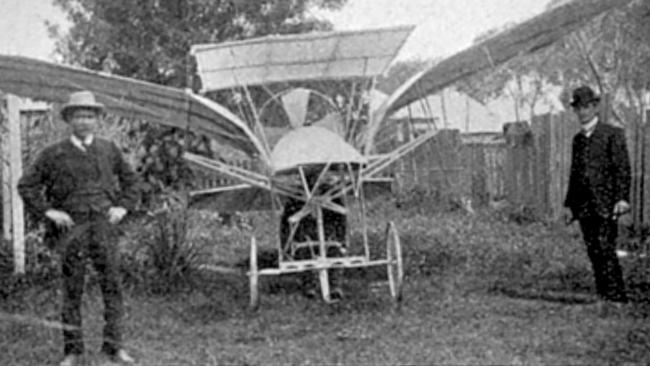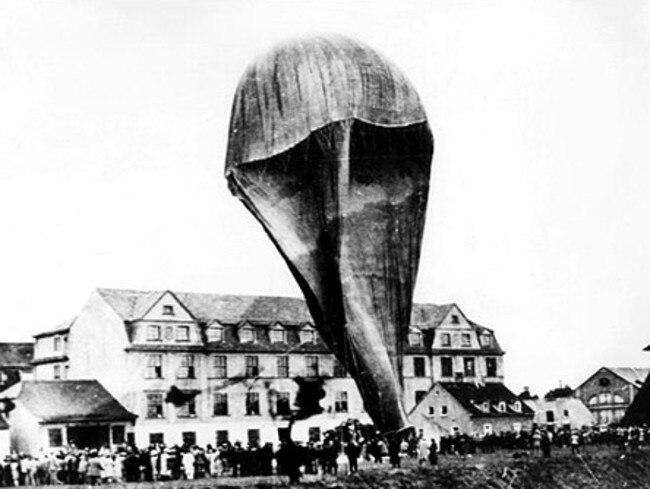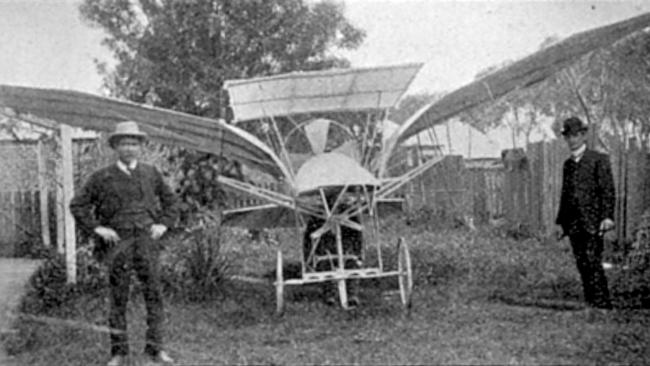Canadian Daniel Boria succeeded but inventors’ early feathered flights of fancy were a fatal fascination
MAN’S earliest attempts at flight were modelled on bird wings and more often than not ended up killing the intrepid adventurer who was convinced he could escape earth’s gravity.

Today in History
Don't miss out on the headlines from Today in History. Followed categories will be added to My News.
IN the latest real-life re-enactment of quirky Australian movie Danny Deckchair, Canadian Daniel Boria soared over Calgary in a plastic lawn chair beneath a rainbow of 110 helium-filled balloons this week.
Planning to parachute into a rodeo at the Calgary Stampede to advertise his cleaning business, Boria, 26, instead landed with a sprained ankle and a $1600 bail bill, charged with mischief causing danger to life.
In the history of man’s fascination with flight, Boria is a resounding success story, making it off the ground and surviving to describe “the most surreal experience you can ever imagine”.
Since Greek legends of Pegasus, the winged horse, and wax and feather wings that carried Icarus and Daedalus, until Icarus flew too close to the sun and melted his wax, man’s earliest attempts at flight were modelled on bird wings.
Turkish scholar Ismail al-Jawhari experimented with wings of feathers and light wood attached to his arms and torso in 1000AD, promising an assembled crowd he would “now fly before your very eyes”, before leaping to his death from the roof of a mosque in Nishapur.
English monk Eilmer of Malmesbury Abbey was inspired by Daedalus when he fastened cloth wings to his arms and feet to launch himself from a 40m tower. After gliding about 200m in 15 seconds, Eilmer seemed to panic and landed suddenly with a bump, breaking both legs which left him with a lifelong limp.
Artist and scientist Leonardo da Vinci included a tail on his birdlike ornithopter design in 1485, while Portuguese nurse Joao Torto added an eagle-shaped helmet with a beak to his elaborate 1540 flying machine.
After promising townsfolk that “this day shall not end before you will see the wonder of wonders, a man who will fly with wings of cloth from the tower of the Cathedral Se ao Campo de Sao Mateus”, at 5pm on June 20, Torto mounted the cathedral.
Flapping as he jumped, he apparently defied gravity to glide a short distance before his mask slipped. Attempting a forced landing on a chapel roof, Torto fell and died a few days later.
Italian mathematician Giovanni Borelli’s conclusion in 1680 that human muscle was inadequate for flight, even with birdlike wings, did not end the tradition of lost life and broken limbs as birdmen leapt from tall buildings. But it shifted the focus to gliding under kites or bladders filled with warm air.

Hot air balloons had been used in China since about 230AD, when Zhuge Liang of the Shu Han kingdom used airborne Kongming lanterns for military signals.
In 559 China experimented with kite flying when Emperor Wenxuan of Northern Qi forced prisoners to launch from a tower attached to a kite. Yuan Huangtou was the sole survivor, successfully gliding over the city walls.
CANADIAN NABBED FOR CHAIR BALLOON FLIGHT
MAURICE GUILLAUX MADE HISTORY WITH FIRST SYDNEY SEAPLANE FLIGHT
French brothers Joseph-Ralf and Jacques-Etienne Montgolfier demonstrated a hot-air balloon at Annonay on June 4, 1783, in a 10-minute unmanned flight.
Reportedly inspired by Joseph’s wife Therese’s observation of skirts billowing from the heat of a charcoal burner used to dry laundry, they built a 10m silk balloon lined with paper, taking up human passengers in October.

Paris scientist Jacques Charles was experimenting with hydrogen gas as a rising agent. With engineers Anne-Jean and Nicolas-Louis Robert, he launched the first unmanned hydrogen-filled balloon in August 1783 then went up in a new manned version himself with Nicolas-Louis Robert in December 1783.
The US military later experimented with an alternative to explosive hydrogen, launching the large, helium-filled cigar-shaped navy blimp C-7 over Washington DC on December 5, 1920. Swiss-born physicist Auguste Piccard and assistant Paul Kipfer rose into the stratosphere over Augsberg, Germany in a pressurised aluminium capsule attached to a large hydrogen balloon, reaching a record 15,785m altitude in August 1932.
After a disastrous attempt with a hydrogen-filled balloon in 1934, in November 1935 Captains Albert Stevens and Orvil Anderson broke Piccard’s record to rise 22km over Rapid City, South Dakota.
When the only direction is up, up and away
US truck driver Lawrence “Lawnchair Larry” Walters popularised helium balloon flights after taking off in his homemade airship on July 2, 1982.
Sitting in a patio chair suspended from 45 helium-filled weather balloons, Walters rose 4600m over San Pedro, California, into controlled airspace near Los Angeles International Airport.
His experiment inspired writer-director Jeff Balsmeyer’s film comedy Danny Deckchair, about a disillusioned truck driver who attached his deckchair to helium-filled balloons.
Originally published as Canadian Daniel Boria succeeded but inventors’ early feathered flights of fancy were a fatal fascination


